Tana Toraja is a region of South Sulawesi in Indonesia, a picturesque mountainous region that is home to an indigenous group known as the Torajans. For the Torajans, the most important thing about life is death and because of this, they have established some of the most unique and complex burial rituals in the world, which continue to be practiced today. But don’t worry, this article – although it may appear somewhat dark (and potentially gruesome and/or shocking) for some people, it is not in the least bit morbid, as these Toraja Death Rituals are one of the biggest celebrations of life you will ever read about.
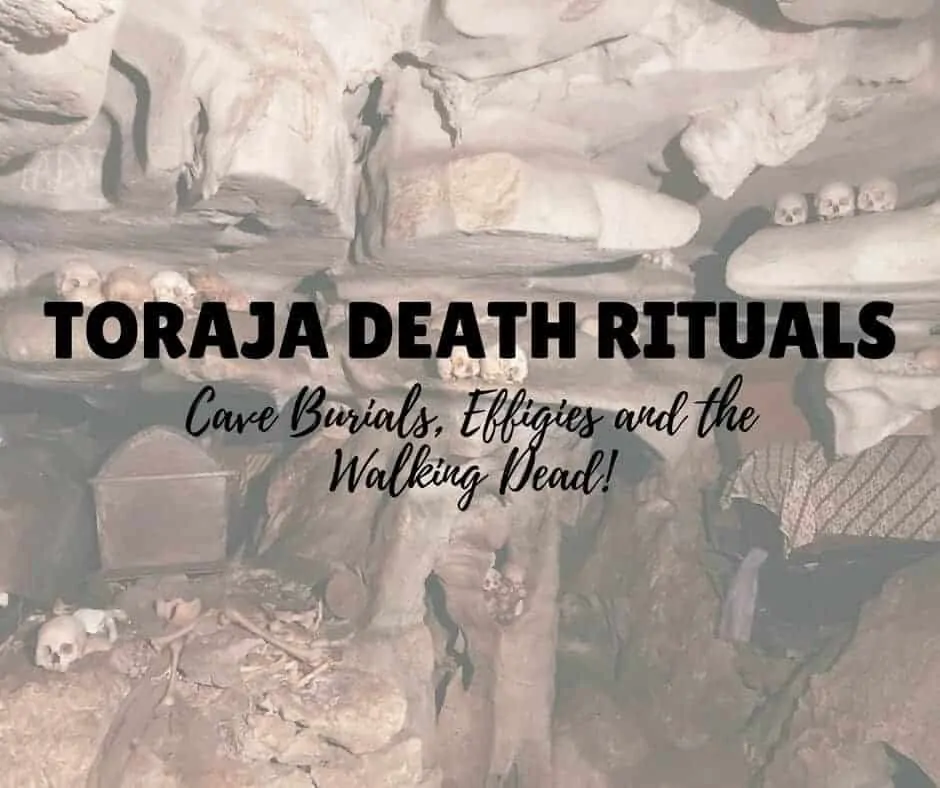
Toraja Death Rituals: Cave Burials, Effigies and the Walking Dead!
Trigger Warning: This post contains images of coffins, human bones & skulls and effigies.
If you’d like a bit more of an intro to Torajan Culture, hop on over to my post about Tana Toraja’s Culture Highlights & Things to do in Indonesia’s Highlands and for those wanting to cast the net a little wider check out my Bucket List Guide to Indonesia which has all the best places to visit across the 17,000 islands!
The Torajans work hard in life to amass wealth for their death, with elaborate funeral rites the ultimate symbol of wealth and prosperity to those both inside and outside the community. The biggest and most lavish festivities are reserved for those of noble standing within the community, with the last ‘pure blooded Torajan noble’ buried in 1972, and event which was documented by National Geographic.
.
What Happens When a Torajan Dies?
The Care of the Body
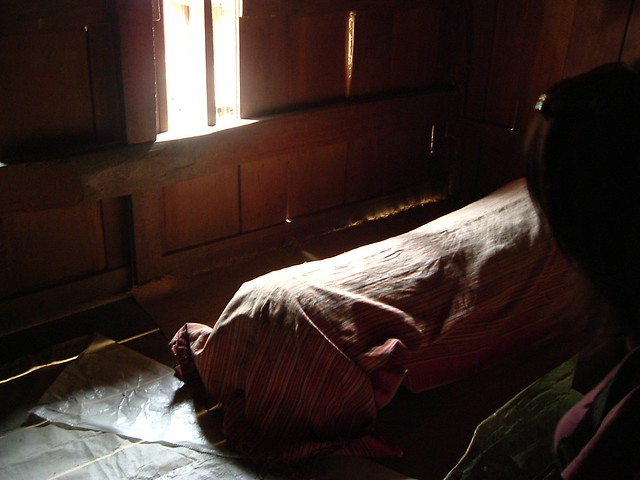
Image (c) Kars Alfrink via Flickr Creative Commons
The Torajan’s believe that death is not instantaneous, but rather it can take months or even years for a person to fully pass over to Puya (the afterlife), and that this can only occur after the body is buried. Until the time of burial the deceased body is kept in the family home, and thought of as a ‘Makula‘ – a ‘sick person’. In order to prevent the body from decaying and putrefying, it was traditionally wrapped in blankets and preserved with herbal elixirs and smoldering fires – although this has largely died out and the bodies are now preserved with formalin (formaldehyde and water) injections, which eventually results in mummification.
The body is kept in a room at the back of the family home, facing south where the Torajan’s believe heaven is located, and is tended to by family members almost around the clock for months/years whilst they prepare financially and emotionally for the funeral. Each day family members will visit the body, talk to body and bring it food and drink up to 4 times a day. The Torajan’s do this out of great respect for the deceased on the premise that although he is ‘Makula‘ his soul remains in the house, and whilst he is in the house he continues to remain a part of the family. Visitors to the house will be introduced to the deceased and great care will be taken to include the deceased in household life.
.
The Tau Tau
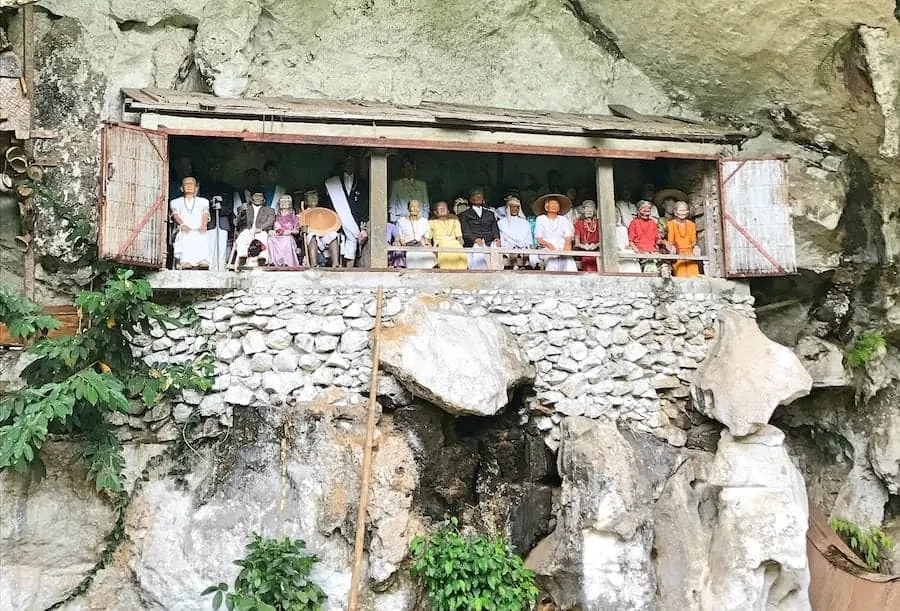
A Tau Tau is a carved wooden or bamboo effigy of the deceased that is usually commissioned upon a person’s death. Tau translates as ‘man‘ and so Tau Tau translates as ‘men‘ or ‘statue‘. Traditionally they were only carved to reveal the gender of their subject but they have become more and more extravagant and a likeness to the deceased is now expected, as is being dressed in an outfit formerly owned by the deceased.
At a cost of over $1,500, they are an extravagance usually reserved for those with higher standing with society. Once created, the Tau Tau remains with the body and is transferred to a lookout above the cave grave entrance at the time of burial. The Tau Tau are thought to protect the deceased and watch over the living.
.
The Funeral Itself
Sacrificial Animals
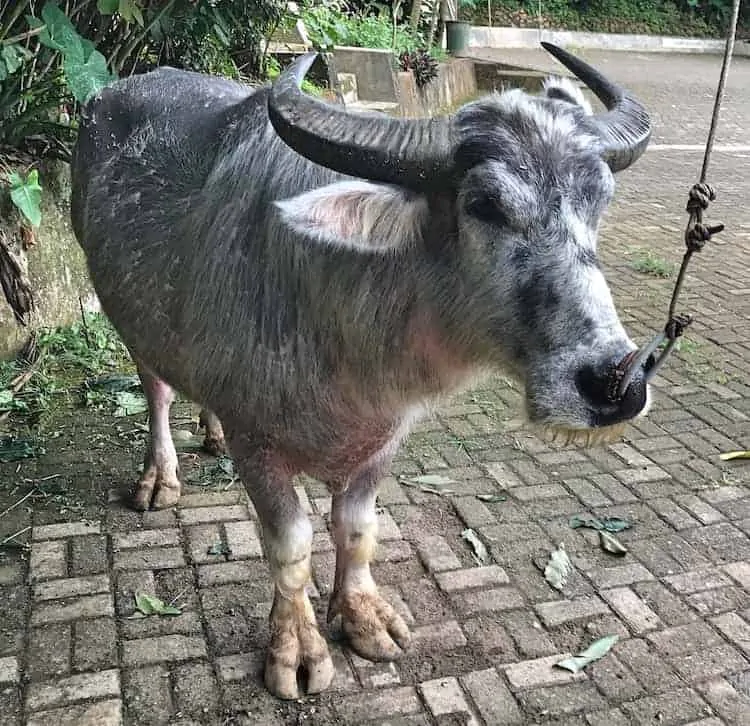
A standard black water buffalo costs around $5,500. Albino buffalo are rare, prized and considerably more expensive.
The wealth of the deceased will dictate the extravagance of the funeral ceremony, and families can take years to amass the wealth and sacrificial animals required before it can be performed. A minimum of 6 water buffalo (at over 100 Million Rupiah each!) are sacrificed at a Torajan funeral, but can be as many as 100 buffalo for those thought of as noble people with high standing in society. (You can probably understand now why it takes so long for the family to collect the required animals and, from a practical reason, why funerals take place so long after death!) The Torajans believe that the buffalo help take the deceased to Puya and that many buffalo will make the journey quicker. The buffalo are slaughtered by having their throat cut to release the spirit and the horns removed to decorate the front of the deceased families home.
Guests to the funeral often also arrive with a pig or buffalo to be sacrificed as a gift to the deceased relatives, and who’s donations are meticulously recorded in order to be repaid at a later date when a member of that family dies, and until such time there is an unseverable bond between the families.
A cockfight or ‘bulangan londong’ is also an integral part of the ceremony. As with the sacrifice of the buffalo and the pigs, the cockfight is considered sacred because it involves the spilling of blood on the earth. Officially, the tradition requires the sacrifice of at least three chickens, but it is common for at least 25 pairs of chickens to be set against each other, as part of the ceremony.
.
Rambu Solo

Image (c) Arian Zwegers via Flickr Creative Commons
The Rambu Solo is the official name of the funeral ceremony (also known as the Death Perfection ceremony) and can take place in the dry season between the months of June and September each year. This is carried out either outside the Tongkoran (traditional house) in the village or in a field (the ceremonial site is known as rante) where bamboo structures are erected for friends and family to watch the festivities from. It is at this time there is lots of wailing, crying, dancing and singing, and when the animals are ritually sacrificed, and the cockfights occur. The meat from the animals is eaten as part of the death feast, with the extra meat split between the attending families to take home. Although the aluk religion (the way of the ancestors) states that only a noble person should be celebrated with a death feast, it has become an integral part of all funeral ceremonies now, with the exception of ceremonies for children and low-status adults..
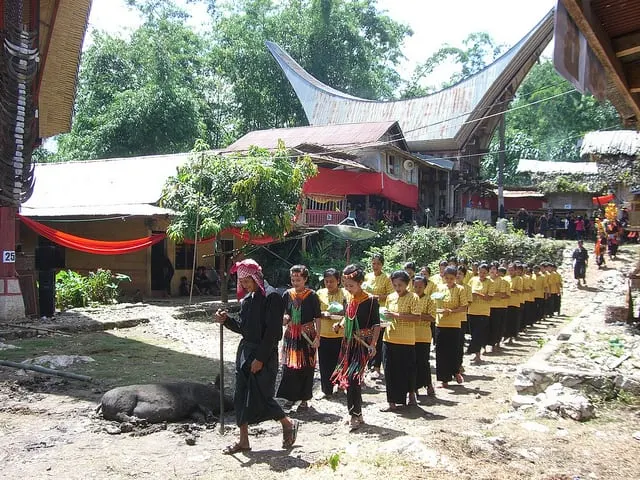
Image (c) Sergey via Flickr Creative Commons
These festivities can run for 2 days or up to 2 weeks depending on the status of the deceased. After which, the body is placed in ceremonial palaquin (which is the shape of a traditional house – Tongkoran) and carried by many men – and accompanied by members of the village – to the burial site behind a procession known as Ma’Palao/Ma’Pasonglo.
Cave Burials
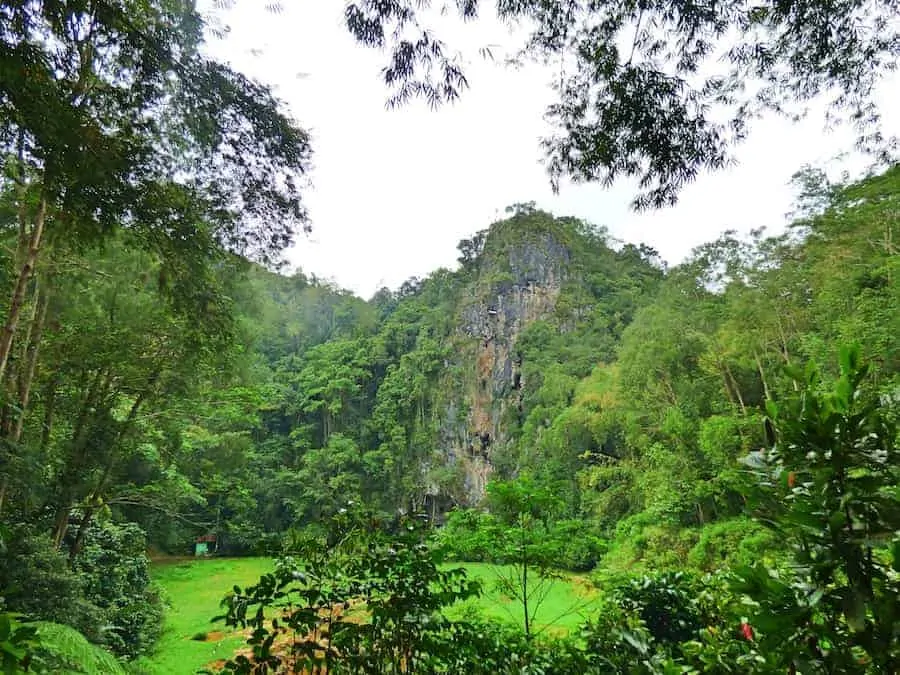
This is the cave burial site of Londa – and if you look closely you can just make out the coffin hanging from just above the center of the cliff side.
The deceased is traditionally buried in a hollowed out cliffside grave that sometimes are as high as 30 meters off the ground. These caves have been hollowed by specialists, who carried out the work without the use of harnesses or safety nets, in exchange for very little pay or sometimes, a couple of buffalo. Generally, the higher up the body is buried, the higher the deceased status in society, and whom had been buried with symbols of their wealth such as gold. The bodies were deliberately placed in hard to reach places to discourage grave robbing. This sometimes included hanging the coffin from the side of the cliff where it remained until the ropes snapped or coffin disintegrated and the remains fell to the ground.
Generally speaking, the lower your status in the family, the lower in the cave you were buried, but this is always above ground. This is because the Torjans believe that the earth represents the mother, who gives life through the land, and to bury bodies in the ground would, in essence, defile that purity.
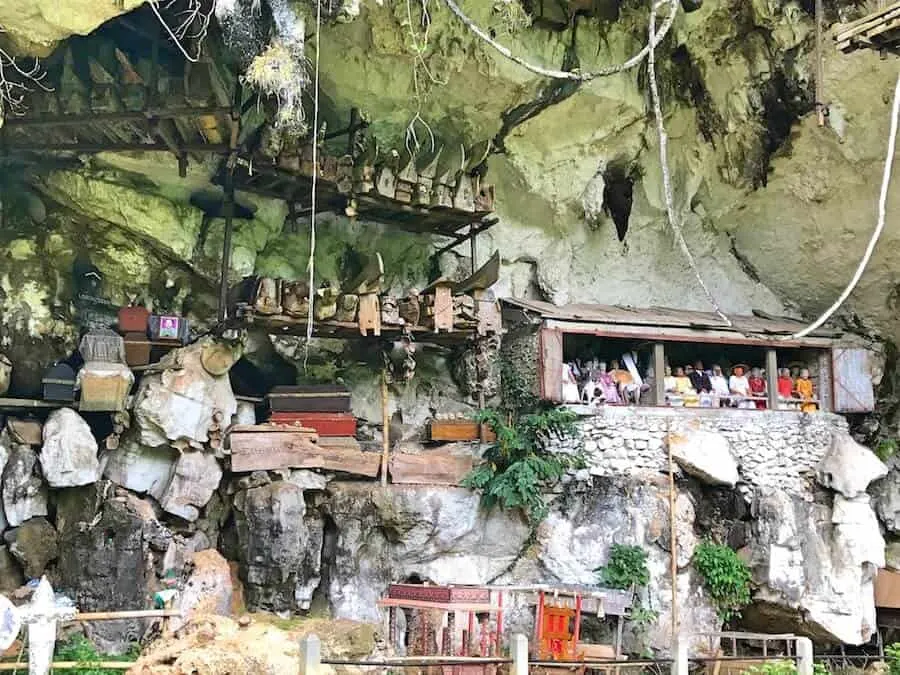
On our visit to Tana Toraja we visited one of these cave grave sites known as Londa. It is unique in that is has two burial sites within the one cave and can be entered by tourists. Outside the cave entrance you can hire a local guide with a lamp who can take you inside the cave and tell you about the history of the residents. It’s absolutely fascinating – but just remember to keep your hands to yourself. There are coffins, skulls and bones on shelves and ledges throughout, and whilst you might be OK with being near them, I doubt you’d feel the same if you inadvertently touched them.. (but that might just be me..)
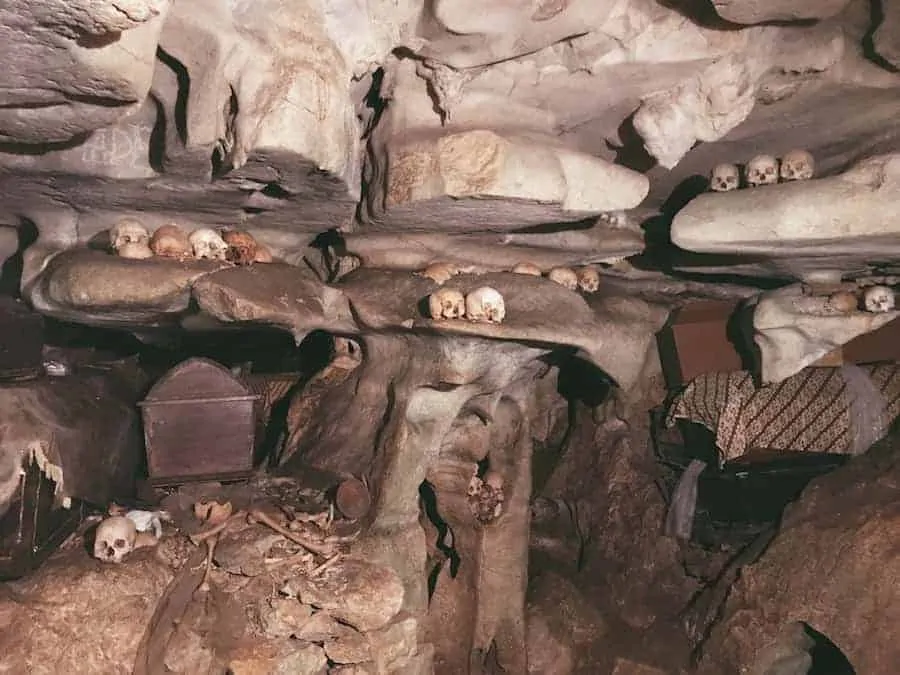
.
The Death of Children
Babies and young children, who have not yet grown teeth at the point of their death are not buried in the manner described above, but rather are wrapped in cloth and placed into a hollowed-out tree trunk and then covered with a palm fiber door. The Torajans believe that when the tree beings to heal, the child’s essence will be one with the tree.
.
Ma’nene – The Ceremonial Cleansing of Corpses
The Ma’Nene festival, carried out in August and translated as the the Ceremonial Cleaning of Corpses. It is often referred to as the ‘second funeral’ and is when relatives of the deceased remove their loved ones from their final resting place to clean the body and dress them in new clothes. During this ceremony, the corpses are often exhibited in the village and paraded around the streets and hence where the ‘walking dead’ references have come from. They do this out of great respect for the dead and often re-inter them with money, cigarettes or clothes (or other things!) that they will need in the afterlife.
.
How to Experience this Cultural Phenomenon for Yourself
Whilst it is possible to visit Toraja at any time of the year, if you want to witness a Rambu Solo or Ma’Nene Celebration, it would be best to time your visit between August and September. The Torajans are happy to welcome visitors to the festivities believing having international visitors in attendance will increase their status in society. Get in touch with the Torajan Tourism Board prior to your visit and they will help point you in the right direction of various celebrations going on in the region.
.
Essential Visitor Info
How To Get to Toraja
You will likely arrive in Indonesia at either Bali or Jakarta International airports. From either of these you will be required to take a short domestic flight to Makassar in South Sulawesi, from which you then have two options:
- Internal flight to Palopo (approx 40 mins) followed by a 2.5 hour rive to Tana Toraja. Search flights here.
- 7-8 Hour Bus from Makassar to Torajaland. Some buses have air conditioning but not all have toilets. Buy your tickets here.
Where To Stay in Toraja
Toraja Heritage Hotel (4*)
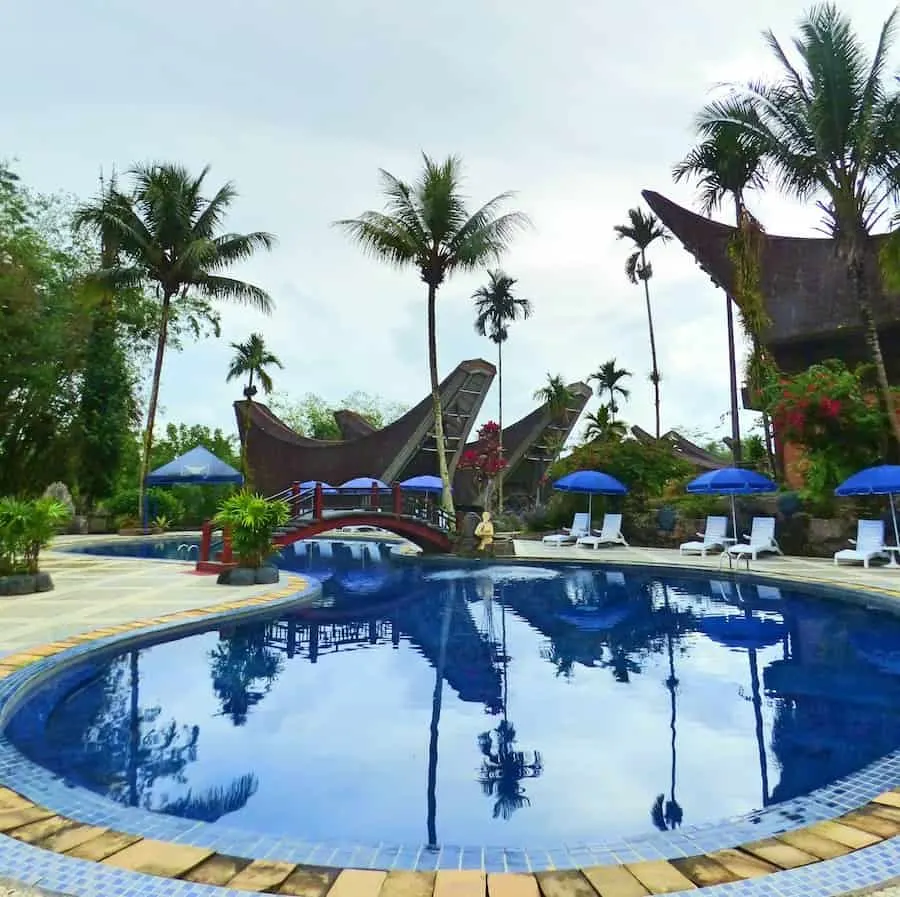
This beautiful hotels sits 700m above sea level with sweeping views of the surrounding hills. The rooms have been built in the style of a traditional Tongkonan and are tastefully decorated inside.
The hotel has an outdoor pool, spa, an onsite restaurant & bar and offers free wifi throughout the property.
Book Now | Compare Prices for Later | Read Trip Advisor Reviews
Or If you have specific accommodation requirements, check out other Hotels in Tana Toraja to narrow down your search.
And that’s a wrap folks! I hope this in depth travel guide has given you an enjoyable sneak peek into the fascinating and complex Toraja death rituals..
..Let me know in the comments below if this is something you would like to see with your own eyes!
FYI: I visited Tana Toraja as part of the Wonderful Indonesia Trip of Wonders 2017 – and I was so fascinated by the rich cultural history and traditions of the region, I couldn’t help but write about it!
READY TO EXPLORE MORE OF INDONESIA & ASIA? YOU MIGHT BE INTERESTED IN THESE ARTICLES
- Indonesia: The Best Restaurants in Seminyak and where to eat in Bali on any budget!
- The Philippines: Top Things to do in Palawan + Where to Stay & How to get around!
- Malaysia: Things to do in Kuala Lumpur + Where to Eat & Where to Stay
- China: There’s more to Xi’an than the Terracotta Warriors – find out all about it in our Xi’an Travel Guide
- The Maldives: Plan the Perfect Trip the Maldives with Options to Suit Every Budget!
Hi There! Thanks for reading my post about Toraja Death Rituals: Cave Burials, Effigies and the Walking Dead! I just wanted to let you know that this travel guide contains affiliate links, which means if you purchase something after clicking a link, I may get a small commission – which is at absolutely no cost to you. If you enjoyed this article and are going to be searching for some of the things I mention anyway, I would love it if you could click through from the links above & thank you in advance! Read my full Disclosure here.


Ariel
Monday 16th of September 2019
Hi! What an insightful article, so helpful to stumble upon your blog!! Can you kindly let me know the best way to find out when/ where these ceremonies are occurring in Toraja once I arrive there? Or is there a way to find out before I arrive? I will be there in a few days! Thank you so much
Vicki Garside
Monday 16th of September 2019
Thank you Ariel - and that's so exciting you'll be visiting the region. I would suggest heading to the Tourist Center (Jl. A. Yani, Rantepao) on arrival in Toraja as they are likely to have the most up to date information on any ceremonies that are planned to be held.
Agness of eTramping
Sunday 1st of October 2017
Tana Toraja seems like a region I would definitely love to explore! Your post was so intriguing and motivating. Keep up the awesome work!
Vicki
Sunday 1st of October 2017
Thank you so much Agness! It really was a fascinating place!
Archana
Thursday 31st of August 2017
This article freaked me out. Coz I get scared by seeing bones and skulls. In fact, this is not the first time I was reading about such a ritual. I experienced the same in Phillippines Sagada district too. They have hanging coffins too.
Mimi & Mitch
Thursday 31st of August 2017
Only have been to Bali in Indonesia. Would love to come back and visit the mountainous regions and learn more about its culture. Not too sure if would be comfortable around skulls and coffins but would love to test it!
Swati Jain
Thursday 31st of August 2017
I shall be going to Indonesia soon and I must say it is a pleasure coming to your blog and reading this. I have a fascination to experience these unique cultures that exist in this world and this, though reads somewhat weird, is still fascinating enough to experience. Loved it